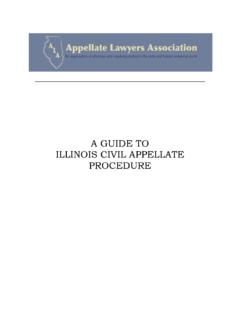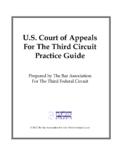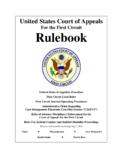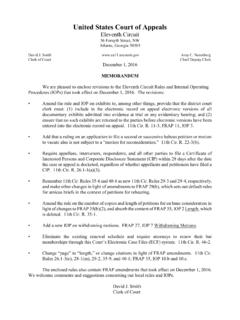Transcription of A Guide to the Rules of Civil Procedure for the Kentucky ...
1 A Guide to the Rules of Civil Procedure for the Kentucky Court of AppealsTable of Contents Forward 1 Introduction and Cautionary Notes 2 The Kentucky Court of Appeals 4 Motion Practice; Formatting and Filing Documents 5 What May Be Appealed 9 Notice of Appeal 12 Prehearing Conference Procedure 15 Record on Appeal 18 Briefing Written Argument 21 Submission and Consideration of Appeals 26 Decisions of the Court 29 Petitions for Rehearing and Motions to Reconsider 32 Further Review in the Supreme Court 34 Final Disposition of Appeals 35 List of Abbreviations and Terms 37-1-ForewordThe Kentucky Court of Appeals is pleased and proud to present a basic practice handbook. It has been in progress for more than two years and was undertaken to address the very real needs of litigants who are proceeding pro se as well as to assist lawyers whose practice does not normally encompass work before our appellate courts.
2 With those dual objectives in mind, this volume seeks to explain the most basic procedures and concepts for the lay litigant as well as to summarize succinctly the numerous Rules governing appellate practice for attorneys embarking into what may be a new area of expertise. Consequently, this publication runs the gamut from simplicity to some measure of sophistication and represents undoubtedly an ambitious endeavor. It is our hope that it will assist many in facilitating their access to our Court. Special thanks to Judge Dan Guidugli of the Court of Appeals and to Lisa Hubbard, his staff attorney. Special appreciation is also due to George Fowler, our Chief Staff Attorney at the Frankfort office of the Court of Appeals, who spent countless hours coordinating this project from start to finish. Sara W. Combs Chief Judge Kentucky Court of Appeals-2-Introduction and Cautionary NotesThis handbook has been prepared as an introductory Guide to completing the steps in the appellate process in the Kentucky Court of Appeals.
3 It is intended to be a simplified explanation with citations to the Rules which should make use of the Rules easier. This handbook is not to be considered a complete practice manual, and it is not a substitute for carefully reviewing a current set of the Civil Rules regarding appeals. It is the responsibility of a person practicing an appeal to have access to a current set of the Rules and follow those Rules . In any apparent conflict between the Rules and this handbook, the Rules will control in all cases. Copies of the current version of the Rules are available in most county law libraries and in some larger public libraries. Access to West s Publishing Company s compilation of the Rules is available through the Court s Web site at by use of the Rules and procedures tag of the Court of Appeals drop-down menu. This handbook deals only with the procedures for practicing an appeal to the Court of Appeals from a judgment in a case originally filed in the circuit court.
4 Various types of cases have special procedures for appellate review which will control over the general procedures set out in this Guide . A partial list of such special procedures are set out Section 4 which is headed What May Be Appealed. It is the responsibility of the person practicing the appeal to be knowledgeable about any special procedures which might govern the type of action involved in that appeal. In some cases, the Court of Appeals may enter orders changing the deadlines or altering Procedure . Examples of this include termination of parental rights cases and cases involving custody of children where a quick but careful decision is essential for the good of the children. When the Court does enter such a special order, the deadlines in the order will control Procedure rather than those in the Civil Rules . A very careful review of any order providing special scheduling is essential. While the staff of the Court will always attempt to be helpful and to assist all parties to the extent possible, members of the staff are not allowed to give legal advice or to make decisions for a party concerning how an appeal should be practiced.
5 Members of the staff should not be asked for legal advice or for advice about what a party should do in a -3-given situation. Parties practicing an appeal should research questions in the statutes and the court Rules . The most recent version of this handbook will be available online at under the Court of Appeals comments concerning the contents, clarity, or usefulness of this handbook should be addressed to:Chief Staff Attorney Kentucky Court of Appeals 360 Democrat Drive Frankfort, Kentucky 40601-4-The Kentucky Court of AppealsThe Kentucky Court of Appeals, as an intermediate appellate court, was created by a group of amendments to the Kentucky Constitution known collectively as The Judicial Article, which became effective on January 1, 1976. Prior to that time, the designation Court of Appeals applied to Kentucky s highest court. When the Judicial Article became effective, Kentucky s highest court became known as the Supreme Court of Kentucky .
6 All records of the old Court of Appeals became those of the Supreme Court. The constitutional provisions concerning the Court of Justice are collected in Sections 109 through 124 of the Kentucky Constitution. The intermediate appellate court was created to ease the heavy work load imposed on the highest court as a result of increased litigation and to make effective the new constitutional right to one appeal in each action. See: Section 115 of the Kentucky Constitution. The intermediate Court of Appeals consists of fourteen judges elected by the citizens of the seven Supreme Court districts defined by KRS The two judges from each district maintain offices within the district from which they were elected. The judges are elected for eight-year terms. Information on the current members of the Court is available on the Court s Web site at on the Judges Directory of the Court of Appeals drop-down menu. The members of the Court of Appeals exercise statewide authority and sit in panels of three in various locations across the Commonwealth.
7 Assignment of the judges is among the responsibilities of the Chief Judge of the Court who is elected by the members of the Court. The central office of the Court, including the office of the clerk, is located in Frankfort. Contact with the Court should be made through the central office at 360 Democrat Drive, Frankfort, Kentucky 40601. The office can be reached by phone at 502-573-7920. -5-Motion Practice; Formatting and Filing DocumentsParties present their arguments on the merits of an appeal through formal briefs. However, in the course of an appeal, it may be necessary to request rulings from the Court on procedural or substantive issues. These may include simple requests for additional time to file a document required by the Rules , complex requests for a stay of enforcement of the judgment, or even dismissal of the appeal. These requests are handled through the Court s motion practice. Motion practiceMotion practice before the Court of Appeals is different from such practice before the trial court in that the parties do not appear at a set motion hour.
8 It is extremely important that the written motion and objections be carefully prepared to present the parties positions. Only in rare cases does the motion panel hear oral presentations on motions. CR (5). When a motion is filed, the motion sits in the clerk s office for the running of response time. Any party is permitted to file a response within ten days of the date of service of the motion. CR (2). If the motion was served on a party by mail, that party is allowed to add an additional three days to the response time. CR (Note: Motions are the only documents filed in the appellate court for which the response time runs from the date of service. Therefore, this is the only instance in appellate practice where CR applies.) After the response time has run or after all responses have been filed, the motion is screened to determine proper handling. Motions requesting any type of substantive relief are assigned to three judge panels of the Court.
9 Procedural motions requiring any application of judicial discretion are assigned to the chief judge or a member of the Court chosen by the chief judge. Purely procedural motions requesting a type of relief which the Court has already determined should be granted are assigned to the administrative ruling docket. The administrative ruling Procedure is intended to quickly rule on certain procedural motions without burdening judicial time. The Court has established certain criteria for motions which will always be ruled on in a certain way. For example, there is no reason for the Court to deny a motion for an extension of time to file a brief that (1) is filed before the due date of the brief, (2) requests only up to a sixty day -6-extension, (3) is the party s first request for such an extension, and (4) is not opposed by other parties. Court staff will carefully review a motion to ensure that a given motion fits all criteria as established by the Court.
10 An administrative ruling is announced by a ruling signed by the clerk of the Court and is generally released within two days of the running of the response time. Procedural motions which do not completely meet the criteria for administrative rulings are submitted to the chief judge or a judge designated by the chief judge on a weekly basis. Orders signed by the chief judge are entered by the clerk s office as quickly as possible after signing. Such orders are generally entered within two weeks following the running of the response time. All substantive motions are assigned to three judge panels for ruling. Such panels meet monthly in Frankfort and may consider up to one hundred items at a sitting. Orders are signed by the presiding judge. Rulings can be expected three to eight weeks after the response time has run. In appropriate cases, a party can request an oral argument before the panel on a substantive motion.










